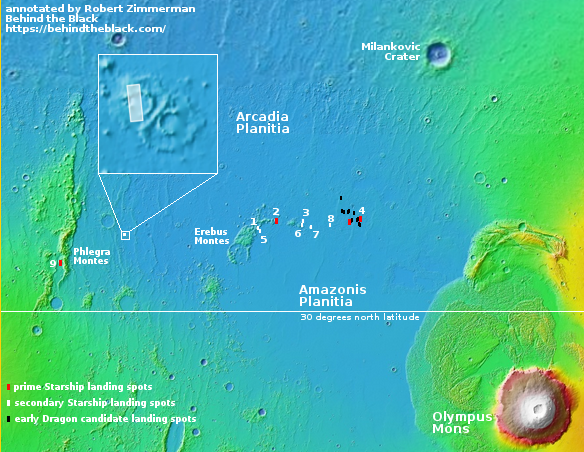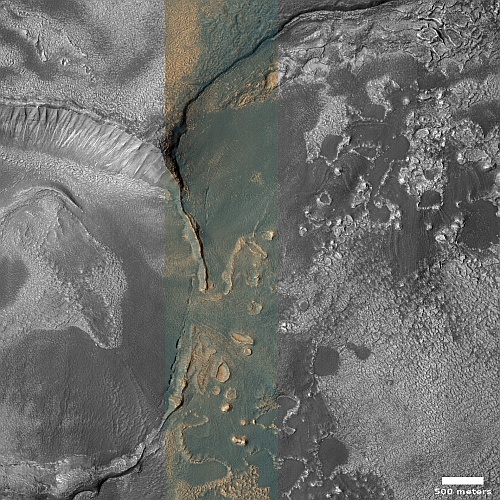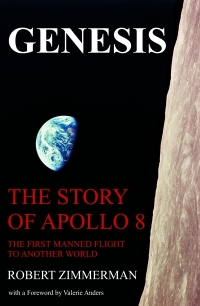Another tourist site for future Starship passengers on Mars
Cool image time! The picture to the right, rotated, cropped, reduced, and sharpened to post here, was taken on April 11, 2023 by the high resolution camera on Mars Reconnaissance Orbiter (MRO). It shows the northwest quadrant of a 7-mile-wide crater whose western rim was smashed by the later impact that created a smaller 2.8-mile-wide crater.
What makes this location interesting is what fills both craters, and how that material appears to flow through a gap in the smaller crater. The color strip suggests the peaks of the rim and small knobs are dust-covered, while the flat materials below are either “coarser-grained materials” that might also have elements of frost or ice within them. The science team thinks ice is involved, having labeled this picture “Ice Flow Features between Craters.”

The white dot in the inset on the overview map to the right marks this location, about 450 to 750 miles west of three prime Starship candidate landing sites, and about 225 miles east of the fourth. Orbital data of this region consistently suggests that it has a lot of near-surface ice. This picture simply reinforces that previous data. The material that fills both craters is thick enough that it buries most of the smaller crater’s rim and even overflows one low point. Though visually the impression is that the flow is going from the east to the west, the grade goes downhill to the east, which means the flow traveled from the larger to the smaller crater.
Similarly, the splash aprons around this crater and one immediately to the east, as shown in the zoomed-in inset, suggest a soft icy surface that melted at impact but quickly hardened. The two equal-sized craters with a straight ridge between suggest that both occurred at the same time, and were part of an object that broke in half before it hit this icy Martian surface.
Though the range of elevation change inside these craters is small, about forty feet from the low to high points, with the highest point on the rim of the smaller crater only about 600 feet high, the views would still be alien and intriguing for those early Starship passengers. Though ice is likely accessibly here, they would not come here for it, since there are much closer sites near the prime landing sites where it would be just as easy to dig up.
They would come for the view.
On Christmas Eve 1968 three Americans became the first humans to visit another world. What they did to celebrate was unexpected and profound, and will be remembered throughout all human history. Genesis: the Story of Apollo 8, Robert Zimmerman's classic history of humanity's first journey to another world, tells that story, and it is now available as both an ebook and an audiobook, both with a foreword by Valerie Anders and a new introduction by Robert Zimmerman.
The ebook is available everywhere for $5.99 (before discount) at amazon, or direct from my ebook publisher, ebookit. If you buy it from ebookit you don't support the big tech companies and the author gets a bigger cut much sooner.
The audiobook is also available at all these vendors, and is also free with a 30-day trial membership to Audible.
"Not simply about one mission, [Genesis] is also the history of America's quest for the moon... Zimmerman has done a masterful job of tying disparate events together into a solid account of one of America's greatest human triumphs."--San Antonio Express-News
Cool image time! The picture to the right, rotated, cropped, reduced, and sharpened to post here, was taken on April 11, 2023 by the high resolution camera on Mars Reconnaissance Orbiter (MRO). It shows the northwest quadrant of a 7-mile-wide crater whose western rim was smashed by the later impact that created a smaller 2.8-mile-wide crater.
What makes this location interesting is what fills both craters, and how that material appears to flow through a gap in the smaller crater. The color strip suggests the peaks of the rim and small knobs are dust-covered, while the flat materials below are either “coarser-grained materials” that might also have elements of frost or ice within them. The science team thinks ice is involved, having labeled this picture “Ice Flow Features between Craters.”

The white dot in the inset on the overview map to the right marks this location, about 450 to 750 miles west of three prime Starship candidate landing sites, and about 225 miles east of the fourth. Orbital data of this region consistently suggests that it has a lot of near-surface ice. This picture simply reinforces that previous data. The material that fills both craters is thick enough that it buries most of the smaller crater’s rim and even overflows one low point. Though visually the impression is that the flow is going from the east to the west, the grade goes downhill to the east, which means the flow traveled from the larger to the smaller crater.
Similarly, the splash aprons around this crater and one immediately to the east, as shown in the zoomed-in inset, suggest a soft icy surface that melted at impact but quickly hardened. The two equal-sized craters with a straight ridge between suggest that both occurred at the same time, and were part of an object that broke in half before it hit this icy Martian surface.
Though the range of elevation change inside these craters is small, about forty feet from the low to high points, with the highest point on the rim of the smaller crater only about 600 feet high, the views would still be alien and intriguing for those early Starship passengers. Though ice is likely accessibly here, they would not come here for it, since there are much closer sites near the prime landing sites where it would be just as easy to dig up.
They would come for the view.
On Christmas Eve 1968 three Americans became the first humans to visit another world. What they did to celebrate was unexpected and profound, and will be remembered throughout all human history. Genesis: the Story of Apollo 8, Robert Zimmerman's classic history of humanity's first journey to another world, tells that story, and it is now available as both an ebook and an audiobook, both with a foreword by Valerie Anders and a new introduction by Robert Zimmerman.
The ebook is available everywhere for $5.99 (before discount) at amazon, or direct from my ebook publisher, ebookit. If you buy it from ebookit you don't support the big tech companies and the author gets a bigger cut much sooner.
The audiobook is also available at all these vendors, and is also free with a 30-day trial membership to Audible.
"Not simply about one mission, [Genesis] is also the history of America's quest for the moon... Zimmerman has done a masterful job of tying disparate events together into a solid account of one of America's greatest human triumphs."--San Antonio Express-News



Come for the view, stay for the doughnuts!